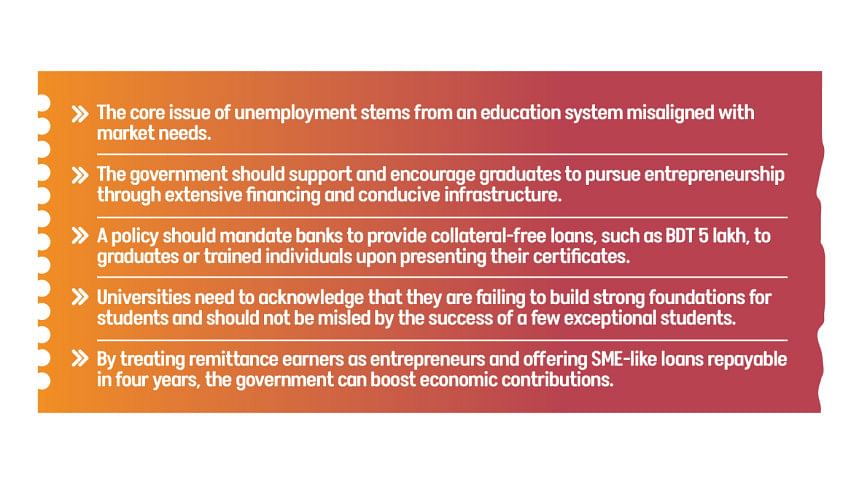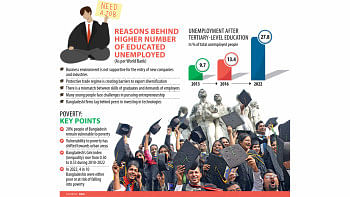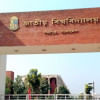What’s wrong with Bangladesh’s job market?

The Daily Star (TDS): Considering that employment was one of the core issues fueling the recent uprising, what measures should the government implement to address this challenge?
AKM Fahim Mashroor (AKMFM): Firstly, the government must understand the root cause of youth unemployment. Most people, including policymakers, neither fully comprehend the problem nor show the willingness to do so. The BBS Labour Force Survey indicates that the overall unemployment rate in Bangladesh is relatively low, around 4 percent. However, what often goes unnoticed is that youth unemployment is not a nationwide problem but rather a challenge specific to a particular segment of the population—tertiary-educated youth.
The unemployment rate among graduates is three times higher than that of non-graduates, revealing a paradox where higher education appears to make employment more difficult. This is because, over the past 10-15 years, Bangladesh has produced more graduates than the job market can absorb. The BBS Survey shows that graduate participation in the labour force rose from 3.6% in 2002 to 3.8% in 2012—a modest increase that aligned with the country's economic growth. However, by 2022, this number had tripled, demonstrating a sharp and sudden surge in the number of graduates over the last decade. Given that our economy remains largely reliant on agriculture and RMG, the demand for graduates remains low. The core issue of unemployment stems from an education system misaligned with market needs.

At present, the government can take three key steps to address the issue of tertiary-educated unemployment. Firstly, language and skill training should be provided to graduates to make them job-ready for foreign markets. The government should finance intensive training programmes, ensuring language skills and job-specific training, targeting a set number of workers per country. Currently, 90% of the workers going abroad are non-graduates, which risks creating a domestic labour shortage. The government should prioritise graduate-focused initiatives, financing training programmes to equip them with the necessary skills and language proficiency for emerging job markets.
Secondly, the government should support and encourage graduates to pursue entrepreneurship through extensive financing and conducive infrastructure. A policy should mandate banks to provide collateral-free loans, such as BDT 5 lakh, to graduates or trained individuals upon presenting their certificates.
Additionally, agriculture faces a crisis, requiring smart, educated youths to venture into agro-entrepreneurship by integrating advanced technologies, including IoT, AI, and satellite applications.
Finally, students completing HSC or intermediate education should be encouraged and provided opportunities to pursue technical and vocational training.
TDS: Based on your experience at BDjobs, could you elaborate on the current employment trends among young graduates in Bangladesh? Specifically, what are their preferred career paths, and what challenges do they face in securing employment?
A.K.M FM: In recent years, the supply of engineering graduates has surged, replacing the earlier dominance of BBA graduates. However, job opportunities in engineering have not expanded proportionally, leading to frustration among fresh graduates. Many pursued engineering inspired by the success of Bangladeshi freelancers and professionals in global tech companies rather than due to local industry growth, which remains underdeveloped. Since Bangladesh lacks a strong export-oriented technical or engineering sector, the increasing supply of graduates in this field has not been met with sufficient job opportunities, exacerbating their frustration.
The major challenge for graduates is the oversupply of manpower across professions. Data from BDjobs indicates that 60–70% of graduates struggle to secure a job even after one to two years of graduation. Most companies hesitate to hire freshers, as many leave within five to six months after basic training, which is a common trend. Unlike larger firms in countries like India, where high employee turnover is manageable, Bangladesh's SMEs, particularly in IT, operate with small teams of 20–30 employees. Losing two to three recruits out of five is a significant setback, making employers prefer experienced candidates. As a result, freshers struggle to secure jobs, limiting their ability to gain experience and trapping them in a frustrating cycle.
Additionally, many fresh graduates assume they must pursue office jobs, overlooking the importance of field sales experience. At BDjobs, we observe that most available jobs are in sales or at the field level. In sales or marketing, careers often begin in the field, but graduates' current mindset prevents them from gaining valuable experience. This generation is much more comfortable with technology, making them more inclined towards social media marketing rather than field sales jobs. This attitude is also a key barrier to their career success and job readiness.

To boost private-sector hiring and job opportunities for graduates, the government could offer financial incentives. A key reform could be subsidising up to 50% of a fresher's salary for six months, encouraging companies to recruit more graduates, a practice seen in India and Pakistan. Additionally, mandatory internships for university students—especially in industrial hubs—would enhance practical skills and employability. While challenging for National University students, targeted collaboration with industries could ensure better workforce readiness.
TDS: How can Bangladesh's education system be better aligned with the job market?
AKMFM: To better align the education system with the job market, foundational gaps in university education must be addressed. For example, students studying accounting should understand basic accounting principles. While we do not expect graduates to be fully skilled, if they lack a strong foundation, it becomes extremely difficult for companies to hire them.
To address this, both the quality of teachers and teaching styles must be improved. Over the past 10 to 15 years, both have been in decline. Universities often argue that they are receiving inadequately prepared students from schools and colleges, largely due to the prioritisation of quantity over quality in primary and secondary education, particularly in the last two decades. This gap is exacerbated by practices such as indiscriminately awarding GPA 5 or granting auto-passes during the COVID-19 period, which undermined academic rigour.
A shift in teaching methodology is essential. Leveraging AI technology for personalised learning could significantly improve teaching quality, particularly in subjects like mathematics and English, where teacher shortages exist in rural areas.
Tertiary education must build on the foundation set by primary and secondary education. Universities need to improve their collaboration with industries to ensure that curricula meet market needs. However, universities should not solely focus on producing graduates for the industry; they must also foster well-rounded individuals.
In addition, the number of general graduates should be reduced, with a greater emphasis on technical education. Non-IT technical fields should be integrated alongside IT programmes to meet the demand for skilled labour across industries. The government must also encourage industry involvement in skill development.
TDS: What changes must the government introduce to promote freelancing and entrepreneurship opportunities among the youth?
AKMFM: To promote freelancing and entrepreneurship opportunities among the youth, the government of Bangladesh should focus on addressing key barriers and creating an enabling environment for skill development, industry growth, and access to global markets.
While the lack of PayPal access is often cited as an issue for freelancers, it is not the primary barrier to success. Freelancing continues to thrive without it, but a more significant challenge lies in the nature of the jobs that many Bangladeshi freelancers engage in, such as graphic design, data entry, and social media marketing. These are low-end jobs that are increasingly at risk of being automated by AI in the coming years. To ensure long-term success in the freelancing sector, the government must prioritise skill development and help freelancers transition to higher-value tasks that leverage emerging technologies.
In addition to supporting freelancers, the government must shift its focus to fostering the growth of larger, export-oriented ICT companies. Freelancing alone will not create a thriving ICT industry. The government should identify and provide targeted support to 50–100 companies with high growth potential.
Furthermore, given that seven to eight lakh graduates enter the workforce annually, the government must also consider supporting youth employment opportunities abroad. Offering loans, particularly to lower-middle-income individuals, would enable young people to access global job markets, send remittances home, and help ease the burden of unemployment. By treating remittance earners as entrepreneurs and providing them with SME-like loans—conditioned to be repaid within four years—the government can empower them to contribute to the national economy. Probashi Kallyan Bank (PKB), which boasts a low loan default rate of 6–7% among expatriates, demonstrates the success of providing loans to expats. The government should consider expanding similar loan facilities for the youth, enabling them to establish themselves as entrepreneurs in the global market while simultaneously contributing to the country's economy through remittances.
TDS: What measures can be taken to enhance the social recognition of TVET programmes to attract students?
AKMFM: To enhance the social recognition of TVET (Technical and Vocational Education and Training) programmes, technical education should be integrated into mainstream academic pathways to bridge the existing skills gap.
Currently, private universities in Bangladesh allocate 40-45% of their programmes to engineering disciplines, producing a large number of STEM graduates, whereas public universities offer only 18-19% of engineering courses. National University (NU) colleges, however, focus primarily on non-technical fields such as history, sociology, and Islamic philosophy, which have limited demand in today's job market. This mismatch leaves many NU graduates underprepared for the workforce, with statistics from Bdjobs showing that 50-60% remain unemployed even five years after graduation.
One effective solution would be to update the NU curriculum by incorporating technical and vocational training. Even students studying non-technical subjects like Bengali or history should be required to complete a 3-6 month technical or vocational course in areas such as caregiving, hospitality management, or electronic repair.
While the NU curriculum must be updated to include technical education, TVET courses must also be elevated to enhance social acceptance. This can be achieved either through structural mergers or collaborations between NU and TVET institutions—the government must determine the best approach. What is certain is that technical education must be promoted; otherwise, we will remain trapped in a cycle of tertiary-educated unemployment.
TDS: What initiatives could be introduced to re-engage the large number of young people not in employment, education, or training (NEET), particularly young women?
AKMFM: To re-engage NEET youth, particularly young women, initiatives must address both structural and cultural barriers. The NEET population stands at around 10-15%, with young women comprising the majority. Many face challenges in continuing their careers after marriage due to socioeconomic and cultural factors.
Although the number of women in education has increased, their participation in the workforce remains low, particularly in formal sectors. In contrast, rural women have higher engagement in agriculture, while urban youth are increasingly moving away from agricultural work in favour of city jobs. This results in a paradox where rural women are more actively employed, yet urban women remain underrepresented in the workforce.
One key opportunity to address this disparity is the expansion of remote job opportunities for women. Roles in online marketing, data entry, and other digital sectors offer flexibility, enabling women to balance their professional and personal responsibilities. In my own company, for instance, 60-70 employees work remotely, 60% of whom are women. We prioritise women in our remote hiring policies, and encouraging other companies to adopt similar practices could create more opportunities for women to enter the workforce without the constraints of traditional office settings.
Moreover, a broader cultural shift is necessary to challenge social norms and reduce the stigma surrounding women's employment. This shift requires joint efforts from both the public and private sectors to create an inclusive and supportive work environment. Additionally, the government could introduce policies that incentivise businesses to hire more women for remote or flexible roles while also investing in training and skills development programmes.
The interview was taken by Miftahul Jannat.

 For all latest news, follow The Daily Star's Google News channel.
For all latest news, follow The Daily Star's Google News channel. 










Comments